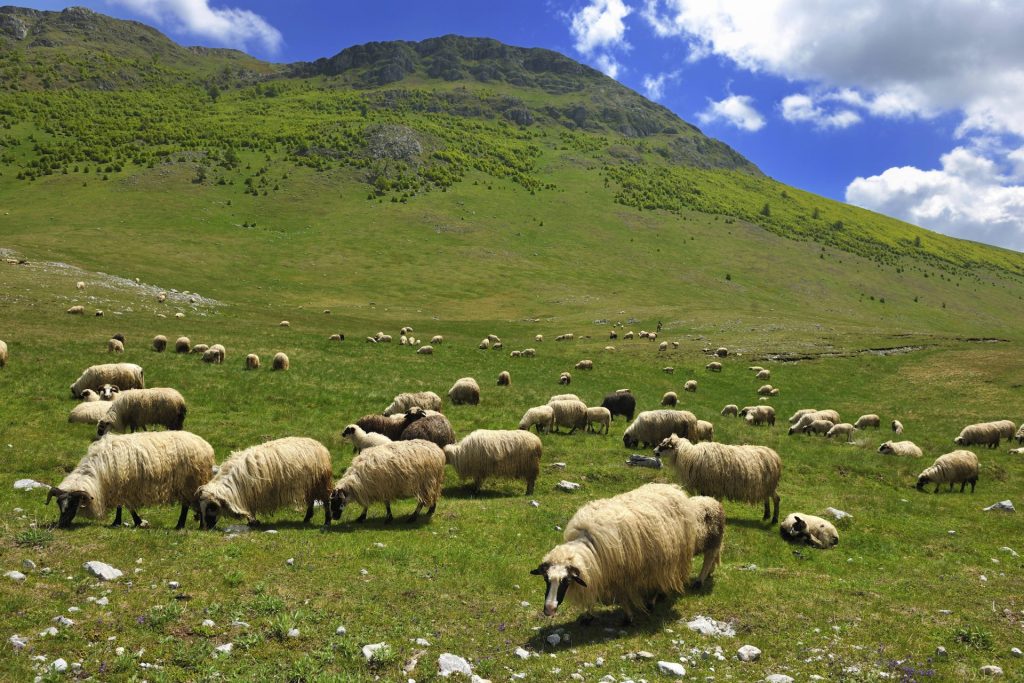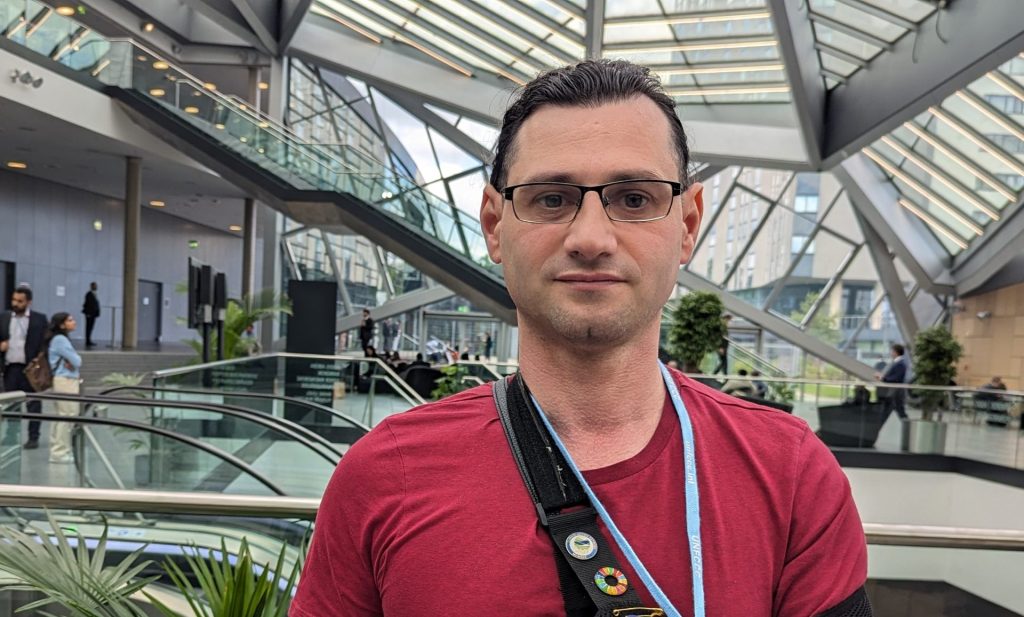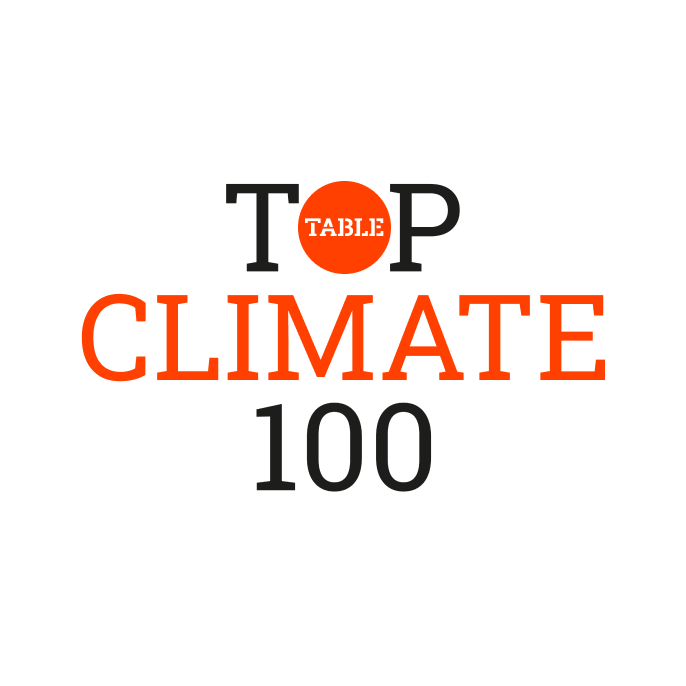Today, we are reporting on black sheep from New Zealand, where the third attempt to put a price on agricultural climate emissions has failed. The new center-right government has also cut the budget for climate action. To make matters worse, oil and gas exploration is to be facilitated. Marc Daalder analyzes what the new policy means for climate action in New Zealand.
Imprisoned journalists, human rights violations, the influence of the oil lobby – COP29 host Azerbaijan is being criticized. The country also lacks experience in climate policy, says Nugzar Kokhreidze from the Climate Action Network (CAN) in an interview with Lisa Kuner and Samira El Hattab.
We also report on a study today that suggests that the UN Intergovernmental Panel on Climate Change (IPCC) has probably underestimated global warming due to the rise in CO2 concentrations. There has also been an incorrect estimate of how many jobs the European solar industry needs. Furthermore, find out what the USA and China are planning in terms of carbon pricing. And there is also good news – about the expansion of wind energy in Germany.


Since the unveiling of 3.7 billion NZD in cuts to climate policy in its first Budget, the new New Zealand Government has subsequently announced plans to abandon two of its predecessor’s key emissions reduction initiatives:
The government says declining gas supply is putting New Zealand’s energy security at risk and is a result of the 2018 ban on issuing new offshore exploration permits. This announcement has been seized on by the UK Conservative Party, to attack the UK Labour Party’s policy for a similar ban on new offshore exploration ahead of the July 4 election.
However, the New Zealand Government’s talking points don’t quite stack up. It has historically taken at least a decade from finding new offshore gas to production beginning in New Zealand, meaning new supply from 2018 wouldn’t be on the market until 2028 at the earliest. Moreover, there are existing discoveries which can still legally be drilled. A New Zealand energy company applied for a permit to do so just last year. And a report drawn up in 2023 to inform the previous government’s plan to transition away from gas found that existing onshore fields alone are enough to supply New Zealand’s electricity sector on the path to net zero emissions by 2050.
The reason for declining supply is not the 2018 ban, but the reality that offshore exploration and production in New Zealand is a poor investment. It’s a country with binding net zero targets and carbon budgets and where the Opposition has pledged to reinstate the offshore ban if it is repealed. In other words, long-term demand is unlikely to be there and sovereign risk is a further disincentive.
The most likely outcome of the repeal of the ban is that no new oil and gas is produced, given these factors. But it may still do harm to New Zealand’s relationship with the Pacific Islands, which it has traditionally worked closely with in climate negotiations. Vanuatu’s Climate Change Minister Ralph Regenvanu last year urged the new government not to repeal the ban, while Palau President Sonny Whipps Jr. called the move “tragic” and “backwards.”
The same week as the repeal of the ban was announced, Agriculture Minister Todd McClay and Climate Minister Simon Watts announced they would amend New Zealand’s Zero Carbon Act to remove a 2025 deadline for the entry of agriculture into New Zealand’s Emissions Trading Scheme (NZETS).
The NZETS covers all sectors except agriculture. Significant negotiations between the sector and the previous government secured an agreement in 2019 to price emissions from livestock by 2025 at the latest. Over time, both the government and the sector came to agree that the NZETS is not the best tool for doing so, as it conflicts with New Zealand’s split-gas approach where methane targets are split out from long-lived gas (CO2 and N2O) targets because of their differing warming impacts. Instead, a partnership between the sector and government developed a bespoke, farm-level pricing plan which would have placed a levy of just 0.09 NZD per kilo of lamb and half a cent per litre of milk by 2030 – though this would rise over time.
While environmentalists critiqued this plan for its lack of ambition, the sector consensus behind it also began to collapse. This came for two reasons: The leadership of agricultural lobby groups were not in touch with the grassroots who were still majority opposed to any price on emissions and changing political winds suggested they could get a better deal under a centre-right government after the 2023 election. Sure enough, the new government has promised to rework the bespoke pricing scheme and implement it by 2030. At the same time, however, the government has moved to repeal the NZETS backstop.
This marks the third time that plans to price agricultural emissions have failed in New Zealand, after the industry successfully defeated a carbon tax plan in 2004 and had a 2013 deadline for entry into the NZETS scrapped by a previous centre-right government.
Additionally, Agriculture Minister McClay said on June 27 that the government will weaken New Zealand’s methane targets, in defiance of advice from the independent Climate Change Commission. The existing methane targets were set in alignment with pathways from the IPCC’s 2018 report on 1.5C:
The government has commissioned a separate review of what the targets would be if they merely sought to achieve “no additional warming” from agriculture after 2017. In other words, this would “lock in” the warming caused by New Zealand’s agriculture sector to-date, neither contributing to further heating of the planet nor contributing to cooling.
The Climate Change Commission has said this approach would lead to higher emissions and figures from the IPCC suggest the ambition of the methane targets might be more than halved if the “no additional warming” approach is adopted. Nonetheless, McClay said recently that the government would adopt the review panel’s targets, even if it conflicted with the advice of the Climate Commission.

Mr. Kokhreidze, is Azerbaijan a good choice to host the COP29?
No, I don’t think it’s a good choice to host the COP in Azerbaijan or this region. It’s another country with a lot of oil and gas. In recent years, COPs have always been held in countries that are responsible for a lot of emissions. I believe this is the influence of the oil and gas lobby and that is a problem.
Do you share the concern that COP29 will be a greenwashing event?
That is currently the big question. We don’t want it to become a greenwashing event. As civil society, we are committed to this and also see some opportunities for this to succeed.
What exactly are these opportunities?
It may be that Azerbaijan mainly wants to use the COP to boost its image. But this will only work if the COP negotiations are successful and ambitious climate targets are agreed. We at CAN are currently organizing with other stakeholders to convince the COP presidency that this is the best approach.
What challenges do you face?
On the one hand, Azerbaijan is a country with many problems and a democratic deficit. There are repeated reports of human rights violations. Many representatives of civil society had to leave the country. We also see the turbulent situation between Armenia and Azerbaijan, where nobody knows what will happen next and whether the war could flare up again. On the other hand, the country is now facing these huge, important climate negotiations. We are unsure how much leaders actually know about climate diplomacy and how they can steer and facilitate processes.
Do you see Azerbaijan harboring high climate policy ambitions?
I do see ambitions. But from the approach so far, I deduce that there is not enough knowledge and understanding of the processes. That is why Azerbaijan asked the United Arab Emirates and some other governments for assistance. These are the right steps, but one year will not be enough to prepare for such important negotiations. The COP is very complex, even as a participating country. Coordinating everything and achieving global goals as a host is even more complex. The question is how well Azerbaijan will manage this.
This year’s COP will once again discuss the global fossil fuel phase-out. How well can an oil-exporting country coordinate such a phase-out?
Azerbaijan is already confronted with the phase-out anyway, its oil resources are dwindling. Oil drilling is also causing drinking water problems and the water level in the Caspian Sea is dropping. This means that the country will focus on gas in the coming years. However, Azerbaijan will also expand renewables in parallel: Not because it absolutely wants to, but for economic reasons. There are plans for solar projects to become an exporter of green energy to the EU in the future. That is the political vision, but gas is part of it, and that is a problem.
Do you think Azerbaijan is doing enough to promote the fossil fuel phase-out?
No, of course not. The fossil fuel lobby is still very strong, and that won’t change in the coming years.
Azerbaijan declared that this COP will be a COP of freedom. What do you make of this with regard to the human rights situation?
Let’s hope so. It would be great if all political prisoners and representatives of human rights organizations who are currently imprisoned and being mistreated were released. However, I am very skeptical that this will happen. But here’s hoping.
COP29 is also being advertised as the “COP of peace.” Can that succeed?
This narrative comes from the conflict in Nagorno-Karabakh. Azerbaijan won the war, and I think it now wants to show the world what a peaceful country it is. But this is clearly geopolitical propaganda: Thousands of Armenians had to leave Nagorno-Karabakh. They are now refugees who cannot return. Talking about peace in this situation is very problematic.
What is needed to guarantee human rights, particularly press freedom, around the COP?
This is one of the big questions that CAN is working on with representatives from Azerbaijan. We are always told that everything will be fine, everything is safe. In fact, Azerbaijan is also a very welcoming country. But we also see that the government is not particularly open. So I’m not too optimistic: Perhaps the human rights violations around the COP will decrease somewhat, but afterward, everything will be the same again. That’s why we want international support for civil society in the region. Climate justice cannot be achieved without human rights and civil society.
Do you anticipate any problems with protests and journalistic work around the COP?
We have already experienced situations like this in Egypt and Dubai in recent years: The Blue Zone at the COP [the official area of the negotiations, editor’s note] will be the area where protest is allowed. In the rest of the country, there is no freedom of expression, no freedom to demonstrate. It is also difficult to involve the local population if protests outside the COP site are impossible. The situation will not improve much in the run-up to the COP.
Collaboration: Samira El Hattab
July 4, United Kingdom
Elections House of Commons elections in the United Kingdom
The UK re-elects the House of Commons. British Prime Minister Rishi Sunak requested its early dissolution on May 22, 2024. 650 MPs will be elected.
July 7, France
Elections Run-off parliamentary election in France
Following the new elections called by President Macron, the run-off elections will take place this Sunday.
July 8-19, New York
UN meeting High-Level Political Forum on Sustainable Development
The UN Economic and Social Council will hold this High-Level Forum. It discusses the progress towards achieving the Sustainable Development Goals (SDGs). This year’s focus is on SDGs 1, 2, 13, 16 and 17. Info
July 9, 11 a.m. CEST, Online
Webinar What are the key climate priorities for the new UK government
Following the UK election, Carbon Brief is hosting a webinar to discuss the incoming government’s potential climate policy. Info
July 11, 2 p.m. CEST, Online
Webinar The Path to Net Zero: A Climate Mitigation Journey for Banks
In this webinar, the United Nations Environment Program (UNEP) will present the report “Climate Mitigation Journey for Banks” – a net-zero strategy framework that outlines in a single place all the business capabilities that banks need to build and iterate for years to come to align themselves with the Paris Agreement Info
July 11, 2 p.m. CEST, Online
Webinar Spotlighting Cost-Effective and Scalable Solutions to Reduce Methane in the Agriculture Sector
The Climate and Clean Air Coalition (CCAC) is hosting this webinar to discuss how to reduce methane emissions in agriculture quickly and efficiently. Info
July 11-12., Belém
G20 meeting Global Mobilization against Climate Change Task Force
In the G20 cycle, the task force for “Global Mobilization against Climate Change” meets in Belém, Brazil. Info
According to the solar industry, the demand for qualified workers in the European solar sector is growing faster than expected. For this reason, the European Commission gave the green light for a European Solar Academy in late June. The aim is to train 100,000 skilled workers for the solar industry over the next three years. The entire value chain is to be taken into account. The Commission estimates that around 66,000 specialists will be needed in the production of modules and system components alone by 2030. Internal Market Commissioner Thierry Breton spoke of an “urgent skills gap” and has earmarked nine million euros from his budget for the academy’s establishment.
The Solar Academy’s task is to develop teaching programs and training measures in collaboration with the industry and other players in the sector. The European solar industry needs to recruit many additional workers in order to achieve the EU’s expansion targets. The Commission’s RePowerEU plan envisages a photovoltaic capacity of over 320 gigawatts by 2025 and almost 600 gigawatts by 2030. According to the latest EU Market Outlook published by its association, 55.9 gigawatts of photovoltaics were newly installed across Europe in 2023, 40 percent more than in the previous year. Germany and Spain were the main drivers of this development.
Solarpower Europe had initially estimated that the European solar industry would not need a million workers before 2030. However, despite a slight downward trend in forecast growth rates, the association now estimates that this demand for skilled labor will be reached as early as 2025.
Experts say the German solar industry has coped surprisingly well with the skilled labor shortage. Carsten Körnig, Managing Director of the German Solar Industry Association (BSW), says that “according to our estimates, another 5,000 companies from the conventional electrical trade have entered the solar industry in the last two years” has had a positive effect. According to the BSW, the German solar industry currently employs around 118,000 people. The association expects this figure to rise to 138,000 by 2030. ch
A recent study in the scientific journal Nature shows that the concentration of CO2 in the atmosphere is likely having a greater impact on the temperature rise than previously assumed. It suggests that a twofold increase in CO2 concentration could lead to long-term global warming of 7.2 degrees Celsius. The current concentration of CO2 is around 420 ppm; before industrialization, it was 280 ppm.
The results are consistent with similar studies and “are substantially higher than the 2.3 to 4.5 degrees predicted by the Intergovernmental Panel on Climate Change (IPCC),” says Caitlyn Witkowski. She researches climate sensitivity at the Royal Netherlands Institute for Sea Research (NIOZ) in the Netherlands and was the study’s lead author. According to the study, the higher latitudes and the Alpine region could warm by as much as 11.6 degrees. The mid-latitudes, including Central Europe, could become 8.6 degrees hotter and the tropics 5.
The research team analyzed a 45-year-old drill core from the bottom of the Pacific Ocean. It contained particularly well-preserved organic material. This allowed them to determine the CO2 concentration over the past 15 million years and derive the temperature. Geochemist and co-author Jaap Sinninghe Damsté, also from NIOZ, sees this as a “clear warning.” The CO2 concentration “is likely to have a stronger impact on temperature than we are currently taking into account,” says Damsté. lb
The US government must resume processing applications for the authorization of new LNG export terminals with immediate effect. A court in Louisiana made this decision last Monday. 16 Republican states, including Louisiana, West Virginia, Oklahoma, Texas and Wyoming, had filed a lawsuit against the moratorium. The court ruled in their favor. The US federal government is now examining how to respond.
In its ruling, the court concluded that the states had provided sufficient evidence that the pause resulted in a loss of tax and license revenue as well as jobs that could otherwise have been created. The moratorium was “without reason or logic.” By imposing it, the US government had also acted “beyond its scope of authority.”
The White House imposed the moratorium in January in order to assess the impact of the planned LNG exports on the climate, security and the economy. As the New York Times (NYT) reported, US Energy Secretary Jennifer Granholm said the review should be completed “late this year” – possibly after the presidential election in early November. The suing states, on the other hand, called the moratorium an “export ban” in their lawsuit.
The USA is the largest LNG exporter in the world. According to the New York Times, the new terminals already approved alone will double existing export capacity by the end of the decade. The newspaper goes on to write that the moratorium on approvals “galvanized oil and gas companies against Mr. Biden, according to industry lobbyists.”
Yet the industry boomed under Biden’s presidency, as data compiled by Reuters shows. Former President Donald Trump already announced at a fundraising event in May that he would support the oil and gas industry with new pipelines and the resumption of fracking on federally owned land should he be re-elected. ae
Following the strong growth in solar energy in Germany, the expansion of onshore wind energy is now apparently also picking up significantly. According to figures from the German Federal Network Agency, almost 2.4 gigawatts of new capacity had been approved by May 1 this year. This means that the target of 2.5 GW set by the Renewable Energy Sources Act (EEG) has almost been met.
Almost 2.8 GW were put out to tender, with projects totaling nearly 2.5 GW submitted. According to the Network Agency, there have not been comparable volumes since 2017. “With almost 2.5 gigawatts of submitted bids, the current tendering round represents a record and confirms the trend of rising bid and approval figures,” said Network Agency President Klaus Müller. “If this positive development continues, the expansion targets for onshore wind are achievable.”
According to the Agency, the bidding prices were between 7.20 cents and 7.35 cents per kilowatt-hour. Most of the contracts were awarded to North Rhine-Westphalia (727 MW), Lower Saxony (430 MW) and Schleswig-Holstein (318 MW). bpo
Despite various EU programs to promote private and public funding for climate action, there is still a significant investment gap. To achieve the climate target for 2030, investments would have to be doubled to 800 billion dollars annually. Meanwhile, fossil fuel subsidies are increasing in the EU. This is the conclusion of a study by the European Climate Neutrality Observatory (ECNO) – the think tank monitors progress on the EU climate targets. Contributors to the study included the Ecologic Institute and the New Climate Institute.
The authors note that the funding of climate action measures has hardly improved compared to the previous year and has even declined in some cases, jeopardizing further progress in other sectors. The refurbishment of buildings and the transition to zero-emission mobility, for example, progressed far too slowly. Road transport emissions are even going in the wrong direction and have increased.
Carbon removals are also going in “the wrong direction.” Natural carbon sinks continue to decrease. “For a climate neutral future, both natural and technical options need to improve significantly.”
Although there have been small improvements in the socially just transition, overall progress here is still too slow. Although there are more jobs in the renewables sector, fossil fuel subsidies have recently increased more than funding for increasing energy efficiency.
To make the EU climate-neutral by 2050, the ECNO authors recommend
A carbon pricing system for carbon-intensive industrial imports is one of the “range of options” currently being examined by the US government to protect its own industrial base from “free-riding” by foreign manufacturers. John Podesta, the country’s highest-ranking climate diplomat, said this in an interview with the Financial Times (FT). It would be a policy change that attempts to reconcile climate action with the fight against competition from China.
Podesta said that no decision on the “specific political mechanism” had been made yet. But he said there was a “bipartisan conversation about how we tackle this question.” In fact, both Democratic and Republican politicians in the USA have been working on corresponding proposals for some time. However, the political division in the country seems to have made it difficult to reach an agreement.
The US would not “just give up our industrial base to people” who benefit from open global trade that “doesn’t account for, and in fact, kind of subsidizes the dumping of high carbon production cost into open markets,” Podesta continued. The US government was examining the data “to implement a policy framework for that.” A decision is particularly necessary in the steel, aluminum, cement, glass, fertilizer and other CO2-intensive sectors. The European Union is currently introducing a price on CO2-intensive imports with its Carbon Border Adjustment Mechanism (CBAM). ae
By introducing new rules, China intends to reduce the oversupply of carbon emissions credits in its emissions trading system (ETS). The draft rules presented on Tuesday prohibit the customary “borrowing” of credits from the future. It also lays down stricter rules for transferring unused credits from previous years to the present, as Bloomberg reports. According to the responsible environment ministry, the new rules are intended to create a “slight shortage” of carbon certificates on the ETS market.
So far, free carbon credits have been allocated to participating power plants based on a complicated formula. Due to the current oversupply, emissions trading, which started in 2021, has practically no impact on the climate, as critics criticize. Once the planned supply shortage of credits comes into force, it will “send a strong signal to market participants,” Bloomberg quoted Yan Qin, an analyst at the London Stock Exchange Group, as saying. The Exchange estimates the oversupply in China’s ETS to be around 360 million tons of CO2.
The ministry also set new emissions targets for participants for 2023 and 2024. Participants must now report compliance with these targets once a year instead of every two years. In February, Beijing already tightened the fines for participants who manipulate their emissions reports. Currently, 2,257 companies from the energy sector – mainly coal-fired power plants – have to participate in the ETS. An expansion to other sectors is planned; in March, preparations were announced for the inclusion of the aluminum industry, which is expected to take place in 2025.
Meanwhile, a Reuters report on Tuesday revealed that China continues to hold on to fossil fuels alongside the development of renewable capacities: China founded an organization that unites national oil producers and other state-owned companies to explore very deep oil and gas deposits and exploit hard-to-extract non-conventional resources. ck
EU legislators must reorganize the production and supply chains of sustainable aviation fuel (SAF) to accelerate the ramp-up of the eco-fuel. This is the demand of PtX-Lab Lausitz, a practical laboratory for fuels made from green hydrogen. The Refuel EU Aviation regulation already mandates the supply of SAF at EU airports, and demand has already increased. However, PtX-Lab Lausitz argues that airlines and fuel manufacturers still lack the flexibility to claim emissions savings through the production and use of SAF.
The authors of PtX Lab Lausitz call for the broad introduction of a so-called “book and claim” (B&C) system. This would allow an airline to order SAF from a manufacturer, but it would not have to use it itself to claim the entry for climate action. The SAFs are subsequently provided at the airports and blended with the fossil kerosene. It is irrelevant who ultimately uses the sustainable fuel. Accordingly, the actual user cannot claim the emissions savings for themselves.
The authors note that Refuel-EU Aviation already contains B&C approaches that allow providers to meet the mandatory SAF quotas by factoring in the SAF share of the total volume of aviation fuel deliveries. However, the link between this B&C principle and the European Emissions Trading System (ETS) is still missing. This would require airlines to be able to record carbon savings from SAF use in the ETS without having to use the fuel. So far, airlines are only exempt from surrendering carbon credits in the ETS if they use SAF.
The authors also call for strict sustainability criteria for SAF, for example, in line with the EU Renewable Energy Directive (RED). They believe fulfilling the criteria should also be monetizable without excluding less sustainable fuels. For instance, PtX-Lab Lausitz recommends granting market access to suppliers who can only achieve an 80 percent emission reduction compared to fossil kerosene. However, these suppliers could only declare 80 percent of their supply as SAF. luk


Friederike Otto – physicist and attribution researcher, Imperial College London
As a pioneer in the field of attribution research, Friederike Otto has revolutionized climate science. She and her Dutch colleague Geert Jan van Oldenborgh founded the World Weather Attribution initiative in 2015 – and WWA succeeded where research regularly failed: showing if and how individual extreme weather events are actually linked to climate change. For this, the physicist and philosopher has received numerous awards. Otto is the lead author of the sixth IPCC Assessment Report, headed the Environmental Change Institute at Oxford University until 2021 and has since conducted research at the Grantham Institute in London. Her motivation: the pursuit of justice.

Felix Creutzig – Professor of Sustainability Economics of Human Settlements and Head of the Land Use, Infrastructure and Transportation working group, TU Berlin
Felix Creutzig’s research examines what the climate-friendly society of the future could look like – in other words, how housing, transportation and energy systems would need to be built to make everyday life climate-friendly. Creutzig studied physics and medicine and researched the economics of climate change before taking over as head of the working group on land use, infrastructure and transportation at the Mercator Research Institute on Global Commons and Climate Change (MCC) in Berlin in 2012. He contributed to several IPCC reports, including as coordinating lead author of a chapter in the Sixth Assessment Report. Since 2017, he has held the newly established chair for Sustainability Economics of Human Settlements at TU Berlin.

Antje Boetius – Director, Alfred Wegener Institute (AWI)
The German marine biologist and microbiologist specializes in questions of marine material cycles and biodiversity, as well as research into deep-sea ecosystems. She has been Scientific Director of the Alfred Wegener Institute at the Helmholtz Center for Polar and Marine Research (AWI) in Bremerhaven since 2017. She currently focuses on the effects of climate change on the biogeochemistry and biodiversity of the Arctic Ocean. Boetius has been part of more than 50 expeditions on German and foreign research vessels since 1989 and has discovered, among other things, microbial communities that break down methane without the need for oxygen. In 2018, she was awarded the German Environmental Prize.

Ottmar Edenhofer – Director and Chief Economist, Potsdam Institute for Climate Impact Research (PIK)
Climate economist Ottmar Edenhofer is one of the most distinguished voices for consistent global carbon pricing. He teaches as a professor at TU Berlin, runs the Mercator Research Institute on Global Commons and Climate Change (MCC) think tank and heads the PIK with Johan Rockström. He is a member of many science academies and advisory bodies and co-chaired Working Group III of the IPCC from 2008 to 2015. He focuses on the costs of the climate crisis and the opportunities for economically efficient climate action. In his youth, Edenhofer was a member of the Jesuit order and advises Pope Francis on scientific matters, including in the preparation of his encyclical “Laudato Si.” Edenhofer actively participates in political and social debates on climate action, global justice and development policy.

Franziska Tanneberger – Director, Greifswald Mire Center (GMC)
Franziska Tanneberger and her colleagues have managed to positively anchor a bulky and complex topic of high relevance in the public debate in a short space of time: the protection of peatlands and the rewetting of dry peatland areas. This contribution to climate action, biodiversity, sustainable agriculture and water management is part of the agenda of the “Greifswald Moor Centrum” headed by Tanneberger. The landscape ecologist works as a lecturer at the University of Greifswald with her team, supported by the Michael Succow Foundation. They are promoting peatland conservation projects around the world, creating the first world map of peatlands and forming a network of business and science to turn wetlands into sustainable and green areas through “paludiculture.” Tanneberger chaired the Future Council in Mecklenburg-Western Pomerania in 2020/21 and has been a member of the German government’s Sustainability Council since 2023.

Joeri Rogelj – Director of Research, Imperial College London
The Belgian climate scientist analyzes the links between Earth system science and social and societal change, as well as the effectiveness of international climate action agreements, carbon budgets and net zero targets. As one of the world’s foremost researchers, he was the lead author of Working Group I (scientific basis) in the sixth IPCC Assessment Report. He is also a member of the European Science Advisory Board on Climate Change (ESABCC), the EU Commission’s most important advisory body on climate issues.

Carl-Friedrich Schleussner – Head of Integrated Climate Impacts Research Group, International Institute for Applied System Analysis (IIASA)
Carl-Friedrich Schleussner conducts research into the scientific aspects of the climate crisis as well as its impact on society. Before joining IIASA, he headed the climate science division at consultancy firm Climate Analytics. The company works with 130 experts around the world on concepts for energy transition and decarbonization, and evaluates the climate measures of countries. Schleussner primarily focuses on issues relating to international climate negotiations and the possibility of “overshooting” the 1.5 degree target. His working group currently researches models to move “from attribution to accountability” – in other words, from attributing the causes of climate change to taking responsibility. He also holds a PhD in physics and is an honorary professor of geography and the transformation of the human-environment system at Humboldt University in Berlin.

Matthias Duwe – Head of Climate, Ecologic Institute
Matthias Duwe has been following the international climate negotiations as an observer since 1999 and has more than twenty years of experience in EU climate policy. He works as Head of Climate for the Ecologic Institute, where he coordinates the non-profit institute’s climate policy work. He mainly focuses on international climate negotiations and the European Union’s climate and energy policy – in particular, climate framework laws, national energy and climate plans and international climate diplomacy. Duwe studied social sciences with a focus on environmental policy and environmental planning at the University of Oldenburg.

Andreas Knie – Sociologist, Head of the Digital Mobility and Social Differentiation Research Group, Berlin Social Science Center (WZB)
What social contexts lead to new technology? This is the big question that sociologist Andreas Knie keeps asking himself in his research. He wrote his doctoral thesis on the career of the diesel engine and has long advocated a transition in transportation that puts more flexible public services rather than cars at the heart of politics – with the help of digitalization. Knie teaches sociology at TU Berlin, is a member of Scientists for Future and serves on the council of the think tank Agora Verkehrswende. Since 2020, he has headed the research group “Digital Mobility and Social Differentiation” at the Social Science Research Center Berlin (WZB) with Weert Canzler.

Angelika Humbert – Glaciologist, Head of the Ice Modeling Group and Remote Sensing Group, Alfred Wegener Institute (AWI) Bremen
For Angelika Humbert, ice is a unique material that forms the basis of her research. As a glaciologist, she develops – and uses – satellite-based methods to observe the glaciers and ice sheets of the polar regions. She also does this on-site during expeditions to the Antarctic and Arctic. Using the data obtained, she simulates how the ice in Greenland and Antarctica could behave in the future in order to project sea level rise and better assess risks. This is no trivial matter: So far, the ice masses are changing faster than the models show. Humbert studied physics at TU Darmstadt. Her doctoral thesis focused on ice shelves. She founded a glaciology working group in Hamburg and has been at the AWI since 2012. She holds a professorship for ice sheet modeling at the University of Bremen.
Today, we are reporting on black sheep from New Zealand, where the third attempt to put a price on agricultural climate emissions has failed. The new center-right government has also cut the budget for climate action. To make matters worse, oil and gas exploration is to be facilitated. Marc Daalder analyzes what the new policy means for climate action in New Zealand.
Imprisoned journalists, human rights violations, the influence of the oil lobby – COP29 host Azerbaijan is being criticized. The country also lacks experience in climate policy, says Nugzar Kokhreidze from the Climate Action Network (CAN) in an interview with Lisa Kuner and Samira El Hattab.
We also report on a study today that suggests that the UN Intergovernmental Panel on Climate Change (IPCC) has probably underestimated global warming due to the rise in CO2 concentrations. There has also been an incorrect estimate of how many jobs the European solar industry needs. Furthermore, find out what the USA and China are planning in terms of carbon pricing. And there is also good news – about the expansion of wind energy in Germany.


Since the unveiling of 3.7 billion NZD in cuts to climate policy in its first Budget, the new New Zealand Government has subsequently announced plans to abandon two of its predecessor’s key emissions reduction initiatives:
The government says declining gas supply is putting New Zealand’s energy security at risk and is a result of the 2018 ban on issuing new offshore exploration permits. This announcement has been seized on by the UK Conservative Party, to attack the UK Labour Party’s policy for a similar ban on new offshore exploration ahead of the July 4 election.
However, the New Zealand Government’s talking points don’t quite stack up. It has historically taken at least a decade from finding new offshore gas to production beginning in New Zealand, meaning new supply from 2018 wouldn’t be on the market until 2028 at the earliest. Moreover, there are existing discoveries which can still legally be drilled. A New Zealand energy company applied for a permit to do so just last year. And a report drawn up in 2023 to inform the previous government’s plan to transition away from gas found that existing onshore fields alone are enough to supply New Zealand’s electricity sector on the path to net zero emissions by 2050.
The reason for declining supply is not the 2018 ban, but the reality that offshore exploration and production in New Zealand is a poor investment. It’s a country with binding net zero targets and carbon budgets and where the Opposition has pledged to reinstate the offshore ban if it is repealed. In other words, long-term demand is unlikely to be there and sovereign risk is a further disincentive.
The most likely outcome of the repeal of the ban is that no new oil and gas is produced, given these factors. But it may still do harm to New Zealand’s relationship with the Pacific Islands, which it has traditionally worked closely with in climate negotiations. Vanuatu’s Climate Change Minister Ralph Regenvanu last year urged the new government not to repeal the ban, while Palau President Sonny Whipps Jr. called the move “tragic” and “backwards.”
The same week as the repeal of the ban was announced, Agriculture Minister Todd McClay and Climate Minister Simon Watts announced they would amend New Zealand’s Zero Carbon Act to remove a 2025 deadline for the entry of agriculture into New Zealand’s Emissions Trading Scheme (NZETS).
The NZETS covers all sectors except agriculture. Significant negotiations between the sector and the previous government secured an agreement in 2019 to price emissions from livestock by 2025 at the latest. Over time, both the government and the sector came to agree that the NZETS is not the best tool for doing so, as it conflicts with New Zealand’s split-gas approach where methane targets are split out from long-lived gas (CO2 and N2O) targets because of their differing warming impacts. Instead, a partnership between the sector and government developed a bespoke, farm-level pricing plan which would have placed a levy of just 0.09 NZD per kilo of lamb and half a cent per litre of milk by 2030 – though this would rise over time.
While environmentalists critiqued this plan for its lack of ambition, the sector consensus behind it also began to collapse. This came for two reasons: The leadership of agricultural lobby groups were not in touch with the grassroots who were still majority opposed to any price on emissions and changing political winds suggested they could get a better deal under a centre-right government after the 2023 election. Sure enough, the new government has promised to rework the bespoke pricing scheme and implement it by 2030. At the same time, however, the government has moved to repeal the NZETS backstop.
This marks the third time that plans to price agricultural emissions have failed in New Zealand, after the industry successfully defeated a carbon tax plan in 2004 and had a 2013 deadline for entry into the NZETS scrapped by a previous centre-right government.
Additionally, Agriculture Minister McClay said on June 27 that the government will weaken New Zealand’s methane targets, in defiance of advice from the independent Climate Change Commission. The existing methane targets were set in alignment with pathways from the IPCC’s 2018 report on 1.5C:
The government has commissioned a separate review of what the targets would be if they merely sought to achieve “no additional warming” from agriculture after 2017. In other words, this would “lock in” the warming caused by New Zealand’s agriculture sector to-date, neither contributing to further heating of the planet nor contributing to cooling.
The Climate Change Commission has said this approach would lead to higher emissions and figures from the IPCC suggest the ambition of the methane targets might be more than halved if the “no additional warming” approach is adopted. Nonetheless, McClay said recently that the government would adopt the review panel’s targets, even if it conflicted with the advice of the Climate Commission.

Mr. Kokhreidze, is Azerbaijan a good choice to host the COP29?
No, I don’t think it’s a good choice to host the COP in Azerbaijan or this region. It’s another country with a lot of oil and gas. In recent years, COPs have always been held in countries that are responsible for a lot of emissions. I believe this is the influence of the oil and gas lobby and that is a problem.
Do you share the concern that COP29 will be a greenwashing event?
That is currently the big question. We don’t want it to become a greenwashing event. As civil society, we are committed to this and also see some opportunities for this to succeed.
What exactly are these opportunities?
It may be that Azerbaijan mainly wants to use the COP to boost its image. But this will only work if the COP negotiations are successful and ambitious climate targets are agreed. We at CAN are currently organizing with other stakeholders to convince the COP presidency that this is the best approach.
What challenges do you face?
On the one hand, Azerbaijan is a country with many problems and a democratic deficit. There are repeated reports of human rights violations. Many representatives of civil society had to leave the country. We also see the turbulent situation between Armenia and Azerbaijan, where nobody knows what will happen next and whether the war could flare up again. On the other hand, the country is now facing these huge, important climate negotiations. We are unsure how much leaders actually know about climate diplomacy and how they can steer and facilitate processes.
Do you see Azerbaijan harboring high climate policy ambitions?
I do see ambitions. But from the approach so far, I deduce that there is not enough knowledge and understanding of the processes. That is why Azerbaijan asked the United Arab Emirates and some other governments for assistance. These are the right steps, but one year will not be enough to prepare for such important negotiations. The COP is very complex, even as a participating country. Coordinating everything and achieving global goals as a host is even more complex. The question is how well Azerbaijan will manage this.
This year’s COP will once again discuss the global fossil fuel phase-out. How well can an oil-exporting country coordinate such a phase-out?
Azerbaijan is already confronted with the phase-out anyway, its oil resources are dwindling. Oil drilling is also causing drinking water problems and the water level in the Caspian Sea is dropping. This means that the country will focus on gas in the coming years. However, Azerbaijan will also expand renewables in parallel: Not because it absolutely wants to, but for economic reasons. There are plans for solar projects to become an exporter of green energy to the EU in the future. That is the political vision, but gas is part of it, and that is a problem.
Do you think Azerbaijan is doing enough to promote the fossil fuel phase-out?
No, of course not. The fossil fuel lobby is still very strong, and that won’t change in the coming years.
Azerbaijan declared that this COP will be a COP of freedom. What do you make of this with regard to the human rights situation?
Let’s hope so. It would be great if all political prisoners and representatives of human rights organizations who are currently imprisoned and being mistreated were released. However, I am very skeptical that this will happen. But here’s hoping.
COP29 is also being advertised as the “COP of peace.” Can that succeed?
This narrative comes from the conflict in Nagorno-Karabakh. Azerbaijan won the war, and I think it now wants to show the world what a peaceful country it is. But this is clearly geopolitical propaganda: Thousands of Armenians had to leave Nagorno-Karabakh. They are now refugees who cannot return. Talking about peace in this situation is very problematic.
What is needed to guarantee human rights, particularly press freedom, around the COP?
This is one of the big questions that CAN is working on with representatives from Azerbaijan. We are always told that everything will be fine, everything is safe. In fact, Azerbaijan is also a very welcoming country. But we also see that the government is not particularly open. So I’m not too optimistic: Perhaps the human rights violations around the COP will decrease somewhat, but afterward, everything will be the same again. That’s why we want international support for civil society in the region. Climate justice cannot be achieved without human rights and civil society.
Do you anticipate any problems with protests and journalistic work around the COP?
We have already experienced situations like this in Egypt and Dubai in recent years: The Blue Zone at the COP [the official area of the negotiations, editor’s note] will be the area where protest is allowed. In the rest of the country, there is no freedom of expression, no freedom to demonstrate. It is also difficult to involve the local population if protests outside the COP site are impossible. The situation will not improve much in the run-up to the COP.
Collaboration: Samira El Hattab
July 4, United Kingdom
Elections House of Commons elections in the United Kingdom
The UK re-elects the House of Commons. British Prime Minister Rishi Sunak requested its early dissolution on May 22, 2024. 650 MPs will be elected.
July 7, France
Elections Run-off parliamentary election in France
Following the new elections called by President Macron, the run-off elections will take place this Sunday.
July 8-19, New York
UN meeting High-Level Political Forum on Sustainable Development
The UN Economic and Social Council will hold this High-Level Forum. It discusses the progress towards achieving the Sustainable Development Goals (SDGs). This year’s focus is on SDGs 1, 2, 13, 16 and 17. Info
July 9, 11 a.m. CEST, Online
Webinar What are the key climate priorities for the new UK government
Following the UK election, Carbon Brief is hosting a webinar to discuss the incoming government’s potential climate policy. Info
July 11, 2 p.m. CEST, Online
Webinar The Path to Net Zero: A Climate Mitigation Journey for Banks
In this webinar, the United Nations Environment Program (UNEP) will present the report “Climate Mitigation Journey for Banks” – a net-zero strategy framework that outlines in a single place all the business capabilities that banks need to build and iterate for years to come to align themselves with the Paris Agreement Info
July 11, 2 p.m. CEST, Online
Webinar Spotlighting Cost-Effective and Scalable Solutions to Reduce Methane in the Agriculture Sector
The Climate and Clean Air Coalition (CCAC) is hosting this webinar to discuss how to reduce methane emissions in agriculture quickly and efficiently. Info
July 11-12., Belém
G20 meeting Global Mobilization against Climate Change Task Force
In the G20 cycle, the task force for “Global Mobilization against Climate Change” meets in Belém, Brazil. Info
According to the solar industry, the demand for qualified workers in the European solar sector is growing faster than expected. For this reason, the European Commission gave the green light for a European Solar Academy in late June. The aim is to train 100,000 skilled workers for the solar industry over the next three years. The entire value chain is to be taken into account. The Commission estimates that around 66,000 specialists will be needed in the production of modules and system components alone by 2030. Internal Market Commissioner Thierry Breton spoke of an “urgent skills gap” and has earmarked nine million euros from his budget for the academy’s establishment.
The Solar Academy’s task is to develop teaching programs and training measures in collaboration with the industry and other players in the sector. The European solar industry needs to recruit many additional workers in order to achieve the EU’s expansion targets. The Commission’s RePowerEU plan envisages a photovoltaic capacity of over 320 gigawatts by 2025 and almost 600 gigawatts by 2030. According to the latest EU Market Outlook published by its association, 55.9 gigawatts of photovoltaics were newly installed across Europe in 2023, 40 percent more than in the previous year. Germany and Spain were the main drivers of this development.
Solarpower Europe had initially estimated that the European solar industry would not need a million workers before 2030. However, despite a slight downward trend in forecast growth rates, the association now estimates that this demand for skilled labor will be reached as early as 2025.
Experts say the German solar industry has coped surprisingly well with the skilled labor shortage. Carsten Körnig, Managing Director of the German Solar Industry Association (BSW), says that “according to our estimates, another 5,000 companies from the conventional electrical trade have entered the solar industry in the last two years” has had a positive effect. According to the BSW, the German solar industry currently employs around 118,000 people. The association expects this figure to rise to 138,000 by 2030. ch
A recent study in the scientific journal Nature shows that the concentration of CO2 in the atmosphere is likely having a greater impact on the temperature rise than previously assumed. It suggests that a twofold increase in CO2 concentration could lead to long-term global warming of 7.2 degrees Celsius. The current concentration of CO2 is around 420 ppm; before industrialization, it was 280 ppm.
The results are consistent with similar studies and “are substantially higher than the 2.3 to 4.5 degrees predicted by the Intergovernmental Panel on Climate Change (IPCC),” says Caitlyn Witkowski. She researches climate sensitivity at the Royal Netherlands Institute for Sea Research (NIOZ) in the Netherlands and was the study’s lead author. According to the study, the higher latitudes and the Alpine region could warm by as much as 11.6 degrees. The mid-latitudes, including Central Europe, could become 8.6 degrees hotter and the tropics 5.
The research team analyzed a 45-year-old drill core from the bottom of the Pacific Ocean. It contained particularly well-preserved organic material. This allowed them to determine the CO2 concentration over the past 15 million years and derive the temperature. Geochemist and co-author Jaap Sinninghe Damsté, also from NIOZ, sees this as a “clear warning.” The CO2 concentration “is likely to have a stronger impact on temperature than we are currently taking into account,” says Damsté. lb
The US government must resume processing applications for the authorization of new LNG export terminals with immediate effect. A court in Louisiana made this decision last Monday. 16 Republican states, including Louisiana, West Virginia, Oklahoma, Texas and Wyoming, had filed a lawsuit against the moratorium. The court ruled in their favor. The US federal government is now examining how to respond.
In its ruling, the court concluded that the states had provided sufficient evidence that the pause resulted in a loss of tax and license revenue as well as jobs that could otherwise have been created. The moratorium was “without reason or logic.” By imposing it, the US government had also acted “beyond its scope of authority.”
The White House imposed the moratorium in January in order to assess the impact of the planned LNG exports on the climate, security and the economy. As the New York Times (NYT) reported, US Energy Secretary Jennifer Granholm said the review should be completed “late this year” – possibly after the presidential election in early November. The suing states, on the other hand, called the moratorium an “export ban” in their lawsuit.
The USA is the largest LNG exporter in the world. According to the New York Times, the new terminals already approved alone will double existing export capacity by the end of the decade. The newspaper goes on to write that the moratorium on approvals “galvanized oil and gas companies against Mr. Biden, according to industry lobbyists.”
Yet the industry boomed under Biden’s presidency, as data compiled by Reuters shows. Former President Donald Trump already announced at a fundraising event in May that he would support the oil and gas industry with new pipelines and the resumption of fracking on federally owned land should he be re-elected. ae
Following the strong growth in solar energy in Germany, the expansion of onshore wind energy is now apparently also picking up significantly. According to figures from the German Federal Network Agency, almost 2.4 gigawatts of new capacity had been approved by May 1 this year. This means that the target of 2.5 GW set by the Renewable Energy Sources Act (EEG) has almost been met.
Almost 2.8 GW were put out to tender, with projects totaling nearly 2.5 GW submitted. According to the Network Agency, there have not been comparable volumes since 2017. “With almost 2.5 gigawatts of submitted bids, the current tendering round represents a record and confirms the trend of rising bid and approval figures,” said Network Agency President Klaus Müller. “If this positive development continues, the expansion targets for onshore wind are achievable.”
According to the Agency, the bidding prices were between 7.20 cents and 7.35 cents per kilowatt-hour. Most of the contracts were awarded to North Rhine-Westphalia (727 MW), Lower Saxony (430 MW) and Schleswig-Holstein (318 MW). bpo
Despite various EU programs to promote private and public funding for climate action, there is still a significant investment gap. To achieve the climate target for 2030, investments would have to be doubled to 800 billion dollars annually. Meanwhile, fossil fuel subsidies are increasing in the EU. This is the conclusion of a study by the European Climate Neutrality Observatory (ECNO) – the think tank monitors progress on the EU climate targets. Contributors to the study included the Ecologic Institute and the New Climate Institute.
The authors note that the funding of climate action measures has hardly improved compared to the previous year and has even declined in some cases, jeopardizing further progress in other sectors. The refurbishment of buildings and the transition to zero-emission mobility, for example, progressed far too slowly. Road transport emissions are even going in the wrong direction and have increased.
Carbon removals are also going in “the wrong direction.” Natural carbon sinks continue to decrease. “For a climate neutral future, both natural and technical options need to improve significantly.”
Although there have been small improvements in the socially just transition, overall progress here is still too slow. Although there are more jobs in the renewables sector, fossil fuel subsidies have recently increased more than funding for increasing energy efficiency.
To make the EU climate-neutral by 2050, the ECNO authors recommend
A carbon pricing system for carbon-intensive industrial imports is one of the “range of options” currently being examined by the US government to protect its own industrial base from “free-riding” by foreign manufacturers. John Podesta, the country’s highest-ranking climate diplomat, said this in an interview with the Financial Times (FT). It would be a policy change that attempts to reconcile climate action with the fight against competition from China.
Podesta said that no decision on the “specific political mechanism” had been made yet. But he said there was a “bipartisan conversation about how we tackle this question.” In fact, both Democratic and Republican politicians in the USA have been working on corresponding proposals for some time. However, the political division in the country seems to have made it difficult to reach an agreement.
The US would not “just give up our industrial base to people” who benefit from open global trade that “doesn’t account for, and in fact, kind of subsidizes the dumping of high carbon production cost into open markets,” Podesta continued. The US government was examining the data “to implement a policy framework for that.” A decision is particularly necessary in the steel, aluminum, cement, glass, fertilizer and other CO2-intensive sectors. The European Union is currently introducing a price on CO2-intensive imports with its Carbon Border Adjustment Mechanism (CBAM). ae
By introducing new rules, China intends to reduce the oversupply of carbon emissions credits in its emissions trading system (ETS). The draft rules presented on Tuesday prohibit the customary “borrowing” of credits from the future. It also lays down stricter rules for transferring unused credits from previous years to the present, as Bloomberg reports. According to the responsible environment ministry, the new rules are intended to create a “slight shortage” of carbon certificates on the ETS market.
So far, free carbon credits have been allocated to participating power plants based on a complicated formula. Due to the current oversupply, emissions trading, which started in 2021, has practically no impact on the climate, as critics criticize. Once the planned supply shortage of credits comes into force, it will “send a strong signal to market participants,” Bloomberg quoted Yan Qin, an analyst at the London Stock Exchange Group, as saying. The Exchange estimates the oversupply in China’s ETS to be around 360 million tons of CO2.
The ministry also set new emissions targets for participants for 2023 and 2024. Participants must now report compliance with these targets once a year instead of every two years. In February, Beijing already tightened the fines for participants who manipulate their emissions reports. Currently, 2,257 companies from the energy sector – mainly coal-fired power plants – have to participate in the ETS. An expansion to other sectors is planned; in March, preparations were announced for the inclusion of the aluminum industry, which is expected to take place in 2025.
Meanwhile, a Reuters report on Tuesday revealed that China continues to hold on to fossil fuels alongside the development of renewable capacities: China founded an organization that unites national oil producers and other state-owned companies to explore very deep oil and gas deposits and exploit hard-to-extract non-conventional resources. ck
EU legislators must reorganize the production and supply chains of sustainable aviation fuel (SAF) to accelerate the ramp-up of the eco-fuel. This is the demand of PtX-Lab Lausitz, a practical laboratory for fuels made from green hydrogen. The Refuel EU Aviation regulation already mandates the supply of SAF at EU airports, and demand has already increased. However, PtX-Lab Lausitz argues that airlines and fuel manufacturers still lack the flexibility to claim emissions savings through the production and use of SAF.
The authors of PtX Lab Lausitz call for the broad introduction of a so-called “book and claim” (B&C) system. This would allow an airline to order SAF from a manufacturer, but it would not have to use it itself to claim the entry for climate action. The SAFs are subsequently provided at the airports and blended with the fossil kerosene. It is irrelevant who ultimately uses the sustainable fuel. Accordingly, the actual user cannot claim the emissions savings for themselves.
The authors note that Refuel-EU Aviation already contains B&C approaches that allow providers to meet the mandatory SAF quotas by factoring in the SAF share of the total volume of aviation fuel deliveries. However, the link between this B&C principle and the European Emissions Trading System (ETS) is still missing. This would require airlines to be able to record carbon savings from SAF use in the ETS without having to use the fuel. So far, airlines are only exempt from surrendering carbon credits in the ETS if they use SAF.
The authors also call for strict sustainability criteria for SAF, for example, in line with the EU Renewable Energy Directive (RED). They believe fulfilling the criteria should also be monetizable without excluding less sustainable fuels. For instance, PtX-Lab Lausitz recommends granting market access to suppliers who can only achieve an 80 percent emission reduction compared to fossil kerosene. However, these suppliers could only declare 80 percent of their supply as SAF. luk


Friederike Otto – physicist and attribution researcher, Imperial College London
As a pioneer in the field of attribution research, Friederike Otto has revolutionized climate science. She and her Dutch colleague Geert Jan van Oldenborgh founded the World Weather Attribution initiative in 2015 – and WWA succeeded where research regularly failed: showing if and how individual extreme weather events are actually linked to climate change. For this, the physicist and philosopher has received numerous awards. Otto is the lead author of the sixth IPCC Assessment Report, headed the Environmental Change Institute at Oxford University until 2021 and has since conducted research at the Grantham Institute in London. Her motivation: the pursuit of justice.

Felix Creutzig – Professor of Sustainability Economics of Human Settlements and Head of the Land Use, Infrastructure and Transportation working group, TU Berlin
Felix Creutzig’s research examines what the climate-friendly society of the future could look like – in other words, how housing, transportation and energy systems would need to be built to make everyday life climate-friendly. Creutzig studied physics and medicine and researched the economics of climate change before taking over as head of the working group on land use, infrastructure and transportation at the Mercator Research Institute on Global Commons and Climate Change (MCC) in Berlin in 2012. He contributed to several IPCC reports, including as coordinating lead author of a chapter in the Sixth Assessment Report. Since 2017, he has held the newly established chair for Sustainability Economics of Human Settlements at TU Berlin.

Antje Boetius – Director, Alfred Wegener Institute (AWI)
The German marine biologist and microbiologist specializes in questions of marine material cycles and biodiversity, as well as research into deep-sea ecosystems. She has been Scientific Director of the Alfred Wegener Institute at the Helmholtz Center for Polar and Marine Research (AWI) in Bremerhaven since 2017. She currently focuses on the effects of climate change on the biogeochemistry and biodiversity of the Arctic Ocean. Boetius has been part of more than 50 expeditions on German and foreign research vessels since 1989 and has discovered, among other things, microbial communities that break down methane without the need for oxygen. In 2018, she was awarded the German Environmental Prize.

Ottmar Edenhofer – Director and Chief Economist, Potsdam Institute for Climate Impact Research (PIK)
Climate economist Ottmar Edenhofer is one of the most distinguished voices for consistent global carbon pricing. He teaches as a professor at TU Berlin, runs the Mercator Research Institute on Global Commons and Climate Change (MCC) think tank and heads the PIK with Johan Rockström. He is a member of many science academies and advisory bodies and co-chaired Working Group III of the IPCC from 2008 to 2015. He focuses on the costs of the climate crisis and the opportunities for economically efficient climate action. In his youth, Edenhofer was a member of the Jesuit order and advises Pope Francis on scientific matters, including in the preparation of his encyclical “Laudato Si.” Edenhofer actively participates in political and social debates on climate action, global justice and development policy.

Franziska Tanneberger – Director, Greifswald Mire Center (GMC)
Franziska Tanneberger and her colleagues have managed to positively anchor a bulky and complex topic of high relevance in the public debate in a short space of time: the protection of peatlands and the rewetting of dry peatland areas. This contribution to climate action, biodiversity, sustainable agriculture and water management is part of the agenda of the “Greifswald Moor Centrum” headed by Tanneberger. The landscape ecologist works as a lecturer at the University of Greifswald with her team, supported by the Michael Succow Foundation. They are promoting peatland conservation projects around the world, creating the first world map of peatlands and forming a network of business and science to turn wetlands into sustainable and green areas through “paludiculture.” Tanneberger chaired the Future Council in Mecklenburg-Western Pomerania in 2020/21 and has been a member of the German government’s Sustainability Council since 2023.

Joeri Rogelj – Director of Research, Imperial College London
The Belgian climate scientist analyzes the links between Earth system science and social and societal change, as well as the effectiveness of international climate action agreements, carbon budgets and net zero targets. As one of the world’s foremost researchers, he was the lead author of Working Group I (scientific basis) in the sixth IPCC Assessment Report. He is also a member of the European Science Advisory Board on Climate Change (ESABCC), the EU Commission’s most important advisory body on climate issues.

Carl-Friedrich Schleussner – Head of Integrated Climate Impacts Research Group, International Institute for Applied System Analysis (IIASA)
Carl-Friedrich Schleussner conducts research into the scientific aspects of the climate crisis as well as its impact on society. Before joining IIASA, he headed the climate science division at consultancy firm Climate Analytics. The company works with 130 experts around the world on concepts for energy transition and decarbonization, and evaluates the climate measures of countries. Schleussner primarily focuses on issues relating to international climate negotiations and the possibility of “overshooting” the 1.5 degree target. His working group currently researches models to move “from attribution to accountability” – in other words, from attributing the causes of climate change to taking responsibility. He also holds a PhD in physics and is an honorary professor of geography and the transformation of the human-environment system at Humboldt University in Berlin.

Matthias Duwe – Head of Climate, Ecologic Institute
Matthias Duwe has been following the international climate negotiations as an observer since 1999 and has more than twenty years of experience in EU climate policy. He works as Head of Climate for the Ecologic Institute, where he coordinates the non-profit institute’s climate policy work. He mainly focuses on international climate negotiations and the European Union’s climate and energy policy – in particular, climate framework laws, national energy and climate plans and international climate diplomacy. Duwe studied social sciences with a focus on environmental policy and environmental planning at the University of Oldenburg.

Andreas Knie – Sociologist, Head of the Digital Mobility and Social Differentiation Research Group, Berlin Social Science Center (WZB)
What social contexts lead to new technology? This is the big question that sociologist Andreas Knie keeps asking himself in his research. He wrote his doctoral thesis on the career of the diesel engine and has long advocated a transition in transportation that puts more flexible public services rather than cars at the heart of politics – with the help of digitalization. Knie teaches sociology at TU Berlin, is a member of Scientists for Future and serves on the council of the think tank Agora Verkehrswende. Since 2020, he has headed the research group “Digital Mobility and Social Differentiation” at the Social Science Research Center Berlin (WZB) with Weert Canzler.

Angelika Humbert – Glaciologist, Head of the Ice Modeling Group and Remote Sensing Group, Alfred Wegener Institute (AWI) Bremen
For Angelika Humbert, ice is a unique material that forms the basis of her research. As a glaciologist, she develops – and uses – satellite-based methods to observe the glaciers and ice sheets of the polar regions. She also does this on-site during expeditions to the Antarctic and Arctic. Using the data obtained, she simulates how the ice in Greenland and Antarctica could behave in the future in order to project sea level rise and better assess risks. This is no trivial matter: So far, the ice masses are changing faster than the models show. Humbert studied physics at TU Darmstadt. Her doctoral thesis focused on ice shelves. She founded a glaciology working group in Hamburg and has been at the AWI since 2012. She holds a professorship for ice sheet modeling at the University of Bremen.
